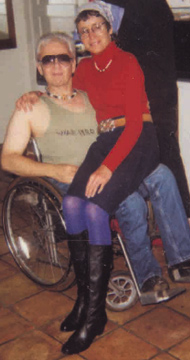12/05/01
Halloween in Berkeley:
3 Fridas, 2 Helens, & John Voight
Frida Kahlo, Helen Keller, and Justin Dart Jr. were waiting at the top of the serpentine, fifty foot ramp. It was a costume party—my first with an all disability theme. That night I met three Frida Kahlos and two Helen Kellers. The invitation read, “Come as disabled person: past or present, fact or fiction.” What fun! It was Halloween in Berkeley, purported home of the independent living movement.
continued:
When we walked in the door we were greeted by Anne Finger, in her wheelchair surrounded by a papier mache bathtub. There were even two, old-fashioned, metal claw feet at the bottom of the tub. Who could she be? She wore a cloth headdress and held a quill pen. Wait, she’s John-Paul Marat, the French revolutionary! She looked just like the Jacques-Louis David portrait, although not dead-looking as in the painting. (Marat had a disability that required him to soak in a tub, where he was when assassinated.)
Then I spied a quad in a cowboy hat.
“Justin, so good to see you! Thank you so much for everything you’ve done.” I said.
“God bless you.” He replied.
Dorthea Lange took Polaroids while Capt. Hook used a disposable camera to document the evening. The Brain That Wouldn’t Die had strange tubes and devices attached to herself. A bio-engineering experiment gone wrong kept everyone guessing. Two of the three blind mice showed up. One was blind, the other pretended.
One of the Helen Kellers was a wheelchair user wearing a blindfold and heavy duty ear protectors. He spent the night having people finger spell their names into his palm. When that got stale he would slowly run his hands over the food table or maneuver around the crowded house using metal rods instead of a white cane. He stayed in character the whole night.

For some twisted reason my first choice was to come as Sir Clifford Chatterley, the impotent husband of Lady Chatterley. I figured that a tweed coat, an ascot tie, and a lap robe would do the trick. Maybe it was when I started thinking about how various prosthetics and Viagra might have changed the story that my wife objected. Actually, I think it was having to dress in 1920s English woolens that left her less than enthusiastic. She fortunately changed my mind.
I came as Sgt. Luke Martin. He was John Voight’s wheelchair-using character in the 1978 movie Coming Home. It was an irresistible role for me as I still had my 1960s Stainless brand wheelchair—the exact same “clunker” wheelchair model used in the movie. My wife came as Sally Bender Hyde, the character played by Jane Fonda in the movie. They were illicit lovers while Sally’s husband was off in Vietnam.
I loved being able to unearth my old Stainless wheelchair from the garage. I remember when I ordered it, thinking, “It’s identical to John Voight’s.” In the 60s Stainless was state-of-the-art. A tank top, dyed green, with “War Hero” inked on the chest, cast-off 1970s disco, aviator shades, and some hippie beads completed the outfit. I was ready to go.
Deciding to come as John Voight’s character in Coming Home was easy. He has been an important icon for me since I saw the movie in 1978. I had only been publicly identifying myself as a disabled person for five years. Hanging out with other disabled people was still new to me in those early days of the independent living movement. When I went to see the movie I wasn’t prepared to see my experience as a disabled person portrayed on the screen. I was shocked that a non-disabled person could get the experience so right when I was still struggling.
I remember walking out of the theater in shock. I saw in the lobby a wheelchair user I had just come to know. He was a Department of Rehab counselor and one of the first disabled professionals I had met. I just stood by him, saying little, taking comfort in his presence. He was one of the disabled people who was teaching me, through example, about being OK as a disabled person.
Back in 1978 I had hoped to see a world where disabled people would redefine society and be successful and fun-loving in our disability identities and experiences. I found that world on Halloween.